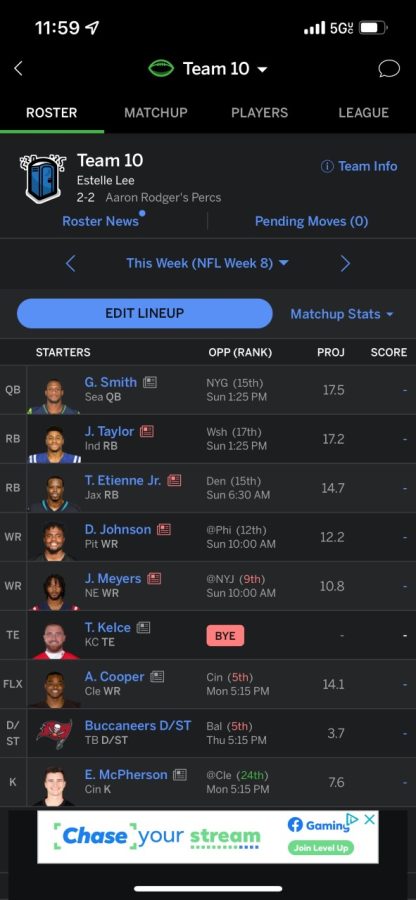From a Newb + Pro: Fantasy Football Tips + Tricks
This fall, Fantasy Football has taken Lakeside by storm. Popular among students and teachers alike, many report being involved in leagues with friends from and outside of school. To ensure that our fellow Lakesiders have the best seasons possible, we’ve written out some of our best tips and tricks for winning, from a newb and a pro. Happy playing!
Estelle’s “Newb” Tips N’ Tricks
“Team 10” — the only team in my Fantasy Football league to stay true to its name — is currently projected to finish in tenth, the best and last place. With my solid experience managing Team 10 for three rounds of Fantasy Football (keeping an impressive 2-1 record), I am here to divulge my sneakiest tips and tricks.
First, pick players projected to score the highest of your options. Scientifically, the computer’s always right. In fact, according to me, the higher the projection number is, the higher your chance of winning is.
Next, ensure that you’re first to pick during drafts. Though the order is predetermined and random, you just have to be lucky. I was. When you’re drafting, draft a quarterback in the first round because they’re the stars of the show. Have you even seen Glee? Other positions are less important besides a solid kicker — the latter usually steals the game. Lastly, pick a running back because there are a lot of them. Once your opposing teams (without my tips) weed out the bad RBs, you’ll be able to score the top available RBs in the game.
When worst comes to worst and rounds of drafting show you nothing but low projection scores and irrelevant RBs (everyone can run anyways), pick your team by their pictures. Often, when a player is not smiling, it demonstrates that they’re one tough cookie who couldn’t even be bothered to smile when hearing “Cheese!” Additionally, the blank faces suggest that the player is so concerned about their dental health that they don’t want to risk damaging any teeth before the game. That is the kind of teamplayer you want, tearing up the field with machismo and a proactive stance on their well-being. If all the remaining players are smiling? Just auto-draft! It typically ends up just as well for me, anyways.
Now, with your full roster of game-winning players, bench the ones that have been known to do the best. Because they have the best playing records, you want to save them for later if the going gets tough. Finally, don’t waste your time on checking player injuries. Football’s a low contact sport.
Follow all of my tips, and you’re sure to come on top. Happy winning, and take the L, Logang!
Evan’s Advice to an Aspiring Fantasy Pro
With years of Fantasy experience under my belt, I’m qualified to debunk a popular theory — projections do not matter. Does ESPN project me to get ninth in the league? Yes. Is my roster only projected 110 this week? Also yes. But the similarities between me and a newb like Estelle end there. Sell your players with the highest projected points this week (but bad rest-of-season outlooks) and claim a bounty from an unsuspecting victim in return.
Instead of platform projections, to really understand in-season metrics, you first need to understand “volume,“ or the amount of opportunities a given player receives in a game. In general, running backs get “carries,” and wide receivers and tight ends are thrown “targets.” Oftentimes a player can receive a lot of volume, but not have a great Fantasy day—that makes for a trade-low candidate, with the hopes that high volume turns into high production in the future.
Next, efficiency statistics are key indicators of a player’s performance over the course of a season, like YPC (yards per carry) and TPPR (targets per route run). Once we’re a good ways into the Fantasy season, YPC and TPPR will begin to stabilize with a high enough sample size. If a player has low volume, but high efficiency metrics, it may be time to trade low for that player; however, first make sure that that player has enough volume upside to realize high production. Any player with enough volume and high efficiency should be considered high-value— volume*(production/volume) = production—trade for them if you can.
Lastly, just because a player is riding high right now doesn’t mean they will continue that way. Keep an eye on a player’s future “strength of schedule,” because at this point in the season, we know that certain defenses are more exploitable at specific position groups than others.
As they say, “an hour of Fantasy a day keeps the punishment away.” Whether that means gaming the waiver wire, sending trade requests to your leaguemates, or constantly talking about Fantasy in the hallways, there’s always work to be done if you want to be a Fantasy champion. Stop what you’re doing and get to work immediately.
Today is gonna be the day that we talk about Estelle Lee,
She's the managing editor, planting the journalism seed.
I'm sure you've heard her name,...

